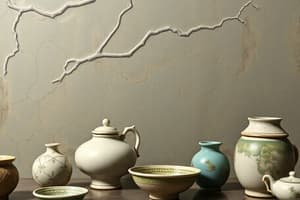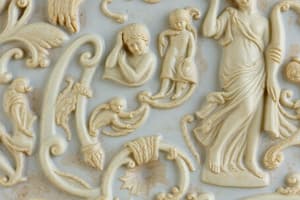Podcast
Questions and Answers
¿Qué técnica de construcción manual implica trabajar con láminas planas de arcilla?
¿Qué técnica de construcción manual implica trabajar con láminas planas de arcilla?
- Estirado (correct)
- Prensado
- Torcido
- Modelado
¿Cuál es el propósito del horneado de bizcocho en el proceso de creación de cerámica?
¿Cuál es el propósito del horneado de bizcocho en el proceso de creación de cerámica?
- Eliminar impurezas de la arcilla
- Fundir la arcilla para dar forma a la pieza
- Endurecer la arcilla y fortalecerla (correct)
- Secar la pieza de arcilla completamente
¿Qué técnica de construcción manual es especialmente útil para estructuras más grandes debido a la estabilidad adicional que proporciona?
¿Qué técnica de construcción manual es especialmente útil para estructuras más grandes debido a la estabilidad adicional que proporciona?
- Anillado (correct)
- Prensado
- Modelado
- Torcido
¿Qué material se utiliza principalmente en la cerámica y en la construcción manual?
¿Qué material se utiliza principalmente en la cerámica y en la construcción manual?
¿Cuál es uno de los pasos finales en la creación de cerámica que implica aplicar capas de esmalte a la pieza?
¿Cuál es uno de los pasos finales en la creación de cerámica que implica aplicar capas de esmalte a la pieza?
¿Cuál es una característica distintiva de la técnica de modelado a mano en cerámica?
¿Cuál es una característica distintiva de la técnica de modelado a mano en cerámica?
¿Qué técnica de modelado manual implica dar forma a un trozo de arcilla directamente con los dedos y los pulgares?
¿Qué técnica de modelado manual implica dar forma a un trozo de arcilla directamente con los dedos y los pulgares?
¿Cuál de las siguientes no es una técnica común de modelado a mano en cerámica?
¿Cuál de las siguientes no es una técnica común de modelado a mano en cerámica?
¿Cuál es uno de los propósitos comunes de los recipientes realizados mediante la técnica de pellizco?
¿Cuál es uno de los propósitos comunes de los recipientes realizados mediante la técnica de pellizco?
¿Qué técnica en cerámica permite a los artistas dar forma a la arcilla sin el uso de un torno de alfarero?
¿Qué técnica en cerámica permite a los artistas dar forma a la arcilla sin el uso de un torno de alfarero?
Flashcards are hidden until you start studying
Study Notes
Introduction
Ceramics is an ancient craft that has been practiced for thousands of years. It involves the use of clay to create objects such as pottery, sculptures, and figurines. One aspect of ceramics that has gained popularity among both amateur and professional artists is handbuilding. This technique allows creators to shape clay without the use of a potter's wheel, offering more freedom and creativity in its application. In this article, we will explore the subtopics of handbuilding, pottery, and types of clays (tipos de arcillas), providing insights into these aspects of ceramics.
Handbuilding
Handbuilding is a technique where ceramic forms are shaped entirely with the artist's hands, without the use of a potter's wheel. It dates back to prehistoric times, predating the invention of the wheel, and remains a fundamental part of modern ceramics. Handbuilding offers flexibility and creativity, allowing artists to experiment with various shapes, textures, and designs. Some common handbuilding techniques include pinching, coiling, and slab building.
Pinching
Pinching is one of the earliest handbuilding techniques, dating back to prehistoric times. It involves shaping a lump of clay directly with your fingers and thumbs, gradually refining the form until it takes the desired shape. This method is suitable for small-scale objects, such as pinch pots, which are often used for practical purposes like holding liquids or storing dry goods.
Coiling
Coiling is another ancient handbuilding technique in which the artist rolls out long strands of clay and joins them together to form a larger structure. This method can be used to create complex forms ranging from bowls to vases, and even architectural elements. Coiling is particularly useful for constructing larger structures because it provides additional stability compared to pinching.
Slab Building
Slab building involves working with flat sheets of clay, typically produced by passing wet clay between large rollers called slab rollers. These slabs can then be manipulated to create various shapes, such as boxes, lamps, or wall hangings. The slab building technique offers a level of precision that can be difficult to achieve using other handbuilding methods.
Pottery
Pottery refers to the craft of making objects from clay that are fired at high temperatures to harden the material. Pottery has a long history, with some of the world's earliest examples being found dating back to around 30,000 years ago. Pottery includes various forms, such as functional ware (dishes, cups, etc.) and decorative items (sculptures, figurines, etc.).
To create pottery, artists usually follow specific steps:
- Preparing the clay: The raw clay is cleaned and mixed with water to form a consistent consistency.
- Shaping the clay: The artist uses their hands or tools to mold the clay into the desired shape. This can involve handbuilding techniques like pinching, coiling, or slab building, or the use of a potter's wheel.
- Drying: The clay piece is allowed to air dry or dried in a specialized drying room to remove excess moisture.
- Bisque firing: The partially dried pottery is placed in a kiln (a large oven) to heat it slowly to a specific temperature (typically around 180°C). This stage hardens the clay and makes it stronger.
- Glazing: To add color and resistance to the final product, artists apply one or more layers of glaze to the bisqueware. Glazes contain minerals and compounds that melt during firing and form a glassy coating on the pottery.
- Glaze firing: The glazed pottery is returned to the kiln for a second firing, typically at higher temperatures (around 1200°C or higher) to melt the glaze and fuse it permanently onto the clay body.
The result of this process is a durable, watertight object that can serve various practical purposes or purely artistic ones.
Types of Clays (Tipos de Arcillas)
Clay, or arcilla, is the primary material used in handbuilding and pottery. Different types of clay offer distinct characteristics that influence the properties of the finished product. Here are some common types of clay:
- Earthenware: This type of clay is relatively soft and porous, making it ideal for beginners due to its ease of handling.
- Stoneware: Stoneware clay is denser and harder than earthenware, resulting in more durable and less porous pottery. However, it requires more skill to work with, as it is more brittle and resistant to shrinkage during firing.
- Porcelain: Known for its translucence and delicate appearance, porcelain clay produces highly refined, nearly white pottery. Working with porcelain requires advanced skills and precise control, due to its low tolerance for error and tendency to crack during the firing process.
Each type of clay has its advantages and challenges, depending on the intended purpose and the skill level of the artist. Understanding the properties of various clays helps ceramicists choose the right clay for their projects and achieve the desired results.
Studying That Suits You
Use AI to generate personalized quizzes and flashcards to suit your learning preferences.




